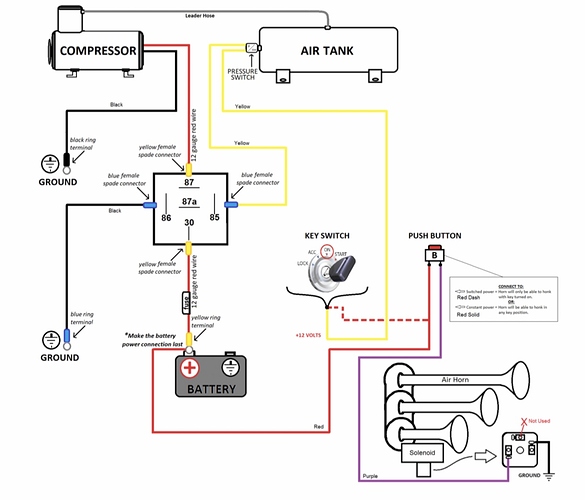I’ve been running the same train/air horn setup for several years without issue. I’m not sure the brand, but if it’s not Vixen, it’s very similar in style. The compressor (30a, 150psi) and tank (1.5 gal) are separate. I ran the system in a car for many years without a relay, which was the way the original instructions said to set up. I’ve recently switched the setup to a new Dodge Ram. The compressor runs fine and kicks off at 150psi like it should. The issue is when the pressure falls below 120psi, as soon as the compressor goes to kick on, it blows the fuse (40a). Even though I am running all 12 gauge wire, I decided to go with a relay setup to see if that helped. Same thing! I have included a picture of the wiring I am currently running with the relay. I have recently changed the horn solenoid as well as tank pressure switch. The only thing I can think is that the compressor is faulty. It runs VERY hot. Any other thoughts would be appreciated. Thanks.
Same issue. Started a week ago. Been running just fine for several months since install. Last week, 35A fuse blows. Couldn’t find any replacements so ordered them. Arrived yesterday and I installed last night. Compressor kicked in when I fired up the truck this morning. Parked and chirped the horn when I got to work and worked fine. Got home, fuse blown again.
Haven’t felt the compressor yet to check temp. Called HornBlasters for support and the guy working said he’s not familiar with the conductors special I bought and to call back during normal business hours Monday.
A couple things.
1.How/ where is the compressor mounted. I have mine in the bed of my truck so it gets air. Check the intake filter. If it is clogged the compressor tries to pull air through the filter, feels resistance, and spikes the current as the motor begins to stall.
-
Take the cylinder head off the compressor. (MAKE SURE TO BLEED ALL OF THE AIR FIRST) and check for rust or dirt contamination. If yo find these, contact the manufacturer and do as they say. If it’s not under warranty, put a bit of compressor oil in the cylinder. When I say a little, I mean a little. Maybe 1 or 2 drops and spread around using a q-tip
-
When the cylinder head is off, take the braided hose off and run some water through it. It should flow one way but not the other. If it flows both ways the check valve is bad. If it doesn’t flow either way, you have a blockage in the supply line. If there is a blockage, it causes the motor to stall and peak the current.
-
Using a multimeter, check the impedance and resistance of the motor windings. (hook up to positive and negative if the compressor) Look at the manual of the compressor or call the company. They should have a value the resistance should be between. A good value is +/- 10% of the rated resistance. No more than 0.05 ohms. Anything over that usually means bad windings and or brushes, assuming it’s a brushed DC motor.
-
Using a clamp meter, measure the current both at start-up and run. Current should be very close to the current value stated by the manufacturer. If it is above that, check the above problems.
-
Check the resistance and current of the solenoid controlling the horns. I’m not sure if you said that you had and issue with that, but I thought I would say it anyway. If is is not within +/- 10%, replace it. They are not that expensive. I hope this helps in any way it can! Let me know what you find.
Thanks so much for the amazing reply. That’s great info that I think a lot of people will find useful. I will get to work and post results. Thanks again!
No problem man. So many people have helped me on this forum and I thought I would return the favor! 
